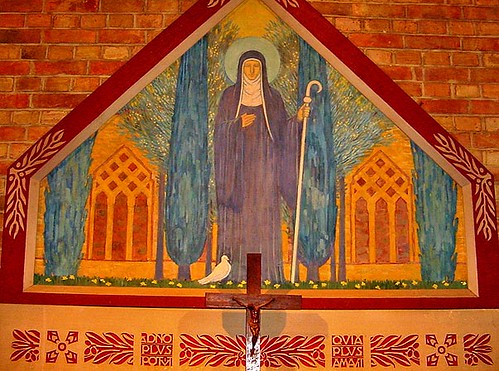In columbae specie Scholasticae anima visa est...

Today, the Church commemorates the patroness of Benedictine nuns, the "dove of virginity" as the Office hymn describes her; this in reference to a legend that St Benedict, her younger brother, saw her soul ascend like a dove to heaven upon her death (cf the Latin title of this post which is taken from the Vespers responsory). As such, the Collect for the Mass used to refer to this vision and saw in it a sign of her innocence and purity of soul. Sadly the post-Vatican II liturgical books do not make any reference to this charming legend which has come to us from St Gregory the Great.
The holy Pontiff tells us that St Scholastica "had been consecrated to God in early childhood" and she "used to visit Benedict once a year, in a house belonging to the monastery a short distance from the entrance." This was obviously a kind of guesthouse where women were received as they were forbidden from entering the monastic enclosure. This house was the scene of their final meeting and the story told is poignant and dramatic. This legend concerning St Scholastica and her brother, St Benedict of Nursia is recounted in the Golden Legend thus:
"Once [St Benedict] went down from the monastery to meet with his sister who had come to visit him, and while they sat at table in the evening, she asked him to stay on with her that night. He absolutely refused to do so. She then lowered her head in her hands to pray to the Lord, and when she raised her head, there came such flashes of lightning, such crashes of thunder, such torrents of rain, that no one could take as much as a step outside the house, although minutes before the sky had been marvellously clear. Her floods of tears had altered the serenity of the air and drawn down the rain. The man of God [Benedict] was aggrieved at this and said: 'May God forgive you sister! What have you done?' 'I begged you,' she answered, 'and you would not listen to me. So I prayed to the Lord and he listened. Now go on your way if you can!' So it came about that they passed the whole night in holy conversation and mutual edification. And behold! Three days after he returned to his monastery, raising his eyes he saw his sister's soul in the form of a dove, penetrating the secret spaces of heaven. He then had her body brought to the monastery and laid to rest in the tomb he had prepared for himself."
That was around AD 547. St Scholastica still lies in a shrine with St Benedict at the ancient monastery of Monte Cassino, where their relics thankfully survived aerial bombing by the Americans in 1944. St Gregory said that it was "fitting that their bodies should be brought together in one tomb as their souls had ever been united."
The story above of their final meeting on earth is interesting because of the dialogue between the saintly siblings. St Scholastica is no gentle dove but obviously a feisty woman and like most elder sisters, well able to deal with her younger brother and even teach him a final lesson about monastic observance. As Sr Felicitas Corrigan, OSB writes: "Before bidding him a final farewell, she teaches the patriarch of the monks of the West an essential lesson: monks have not been made for his sacred night silence any more than man was made for the sabbath: there may be times however rare when the law of charity becomes absolute and supercedes all others. So whether he liked it or not, the monastic lawgiver was made to break his own rule and resume converse with his sister." And this conversation was a "vicaria relatione", 'mutual exchange' about the spiritual things. This reveals their unity of soul and that infact Scholastica was the equal of Benedict except that Pope St Gregory, commenting on this incident, said: "Plus potuit quae plus amavit", 'She prevailed who had the greater love.'
Thus today, we rejoice in the example of St Scholastica and we do well to learn the lesson she taught her brother: that charity is supreme. Therefore she, who is in a sense the Matriarch of Western Nuns, reminds St Benedict of a classic monastic principle that is so well-expressed by another Benedict, the Holy Father, who said: "The entire monastic movement, from its origins with Saint Anthony the Abbot (d. 356), expresses an immense service of charity towards neighbour. In his encounter 'face to face' with the God who is Love, the monk senses the impelling need to transform his whole life into service of neighbour, in addition to service of God" (Deus Caritas Est, 40).
May St Scholastica pray for us and for the whole Benedictine Family that, by her merits and intercession, they may revitalise Europe in love, purity and holiness as once they did in her own time.
The reredos above of St Scholastica is taken from a side altar in Quarr Abbey on the Isle of Wight. Notice the words of St Gregory the Great carved into the stone beneath the painting.







2 Comments:
I have two friends who are Benedictines. Both are in temporary vows. Could you please pray for Sr. Clare Joseph and Sr. Maria Johanna ?
Will do...
Post a Comment
<< Home